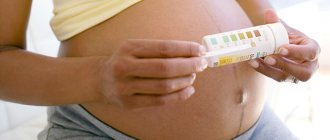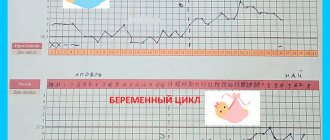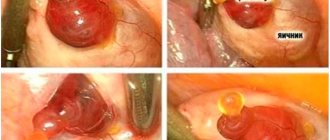Hello girls!
When a woman finds out about her “interesting situation,” she has mixed feelings. On the one hand, this is great joy, on the other hand, it is responsibility. And the second often prevails over the first.
Many questions arise, one of them is what temperature in the vagina during pregnancy will indicate the presence of disorders? Indeed, doctors recommend this procedure as a measure for quality control of the baby’s condition. Why? Let's figure it out.
How to measure BT
We will not give you false hopes and tell you that this is an easy task. Not at all: it requires high discipline, attentiveness and strict adherence to the rules. We are talking about the need to detect almost imperceptible fluctuations of a fraction of a degree, and any error in measurements can become critical.
- Only a very accurate thermometer2 is suitable for measurement. It is best if it is a modern digital device. Read the operating instructions carefully and do not forget to change the batteries in a timely manner. The thermometer cannot be changed during the menstrual cycle - individual errors of different devices can distort the picture.
- Measurements are best taken in the rectum. Measurements in the vagina or mouth are acceptable, but the rectal method is considered to be the most reliable. Whatever method you choose, do not change it during the cycle. Armpit measurements are not suitable for tracking ovulation because they do not provide the necessary accuracy.
- Measurements are taken only in the morning, immediately after waking up3. You cannot get out of bed or make sudden movements; even a short trip to get a thermometer and back to the other end of the room can ruin everything. Prepare a thermometer the night before and place it so that it is at arm's length.
- To avoid spoiling the readings, lie still and do not change your position. Try to do everything to prevent the brain, and after it the body, from switching to “work speed” - do not think about plans for the day, about important matters and problems. Ideally, don't even open your eyes.
- Basal temperature should be measured at approximately the same time every day4. A schedule in which you get up, for example, at 6 am on weekdays, and at 10 am on Saturday and Sunday, is not suitable. To ensure the necessary accuracy, you will have to set the alarm clock at 6 a.m. on weekends, or at most 7 a.m.
In exactly the same way as when planning a pregnancy. It is advisable that you use the same thermometer - if it “lies” a little, at least the readings will be overestimated or underestimated in the same direction as before.
The temperature chart during pregnancy is, in fact, nothing interesting. The most comfortable temperature for fetal development is 37.0–37.3 °C, and your body will try to maintain it throughout the entire period of gestation. Basal temperature in pregnant women can change significantly only in case of pathologies, for example, with a frozen pregnancy or a threat of miscarriage.
Describing how basal temperature changes during the menstrual cycle is useful information, but can be difficult to understand without specific examples. So let's look at some graphs to visualize what measurements you can get4.
Normal menstrual cycle schedule
During the normal course of the menstrual cycle, you can see two different phases on the graph - in the first, the average level of basal temperature is lower than in the second, and ovulation serves as their boundary. It is not necessary that your schedule is divided into two equal parts of 14 days, as in this example. The duration of the second phase of the cycle for different women can be from 12 to 16 days, and the first can vary within even wider limits.
This graph gives an understanding of what basal temperature is normally observed in preparation for pregnancy. In the second phase it should be 0.3–0.6 °C higher than the average level of the first period. At the same time, a drop in the temperature curve is observed at the end of the cycle, before the onset of menstruation. And, of course, the preovulatory drop followed by a rise is important for the expectant mother.
Anovulatory cycle
Anovulatory cycle chart
In the anovulatory cycle, ovulation does not occur, and hormonal levels change slightly. Throughout the entire cycle, the basal temperature remains almost at the same level - around 36.6 ° C, and the graph does not show pronounced phases and drops that are observed in a normal menstrual cycle.
If your temperature curve looks like this in the first month of measurements, there is no need to panic. Every woman has one anovulatory cycle per year, sometimes more. It’s just that your reproductive system periodically needs rest, and it arranges it for itself during periods during which it is impossible to get pregnant. However, if such a picture is observed for more than two months in a row, you need to consult a doctor - this is no longer a rest, but a possible sign of infertility.
Let's look at what a basal temperature graph might look like for various hormonal disorders.
Diagram for corpus luteum deficiency
The corpus luteum forms after ovulation and produces progesterone, which is necessary to prepare the endometrium for implantation of a fertilized egg. If the corpus luteum produces little progesterone, an already begun pregnancy may be terminated.
This condition can be calculated by the slow rise in temperature in the second phase, and for its treatment the doctor will prescribe hormonal drugs.
Schedule for estrogen deficiency
If a high level of progesterone leads to an increase in basal temperature, then an increase in estrogen production leads to a decrease in it. It is thanks to them that the temperature drops before ovulation. With estrogen deficiency, the likelihood of fertilization decreases significantly.
This condition can be identified by an unexpectedly high temperature at the beginning of the cycle, a slow increase in the middle, and a temperature above normal for the second phase. It will not be possible to detect ovulation using such a schedule. In case of estrogen deficiency, hormonal medications are also prescribed.
Pregnancy
Schedule during pregnancy
You determined the day of ovulation using measurements, you have already had that same sex. Keep monitoring - you may soon be able to detect pregnancy even before the test shows two lines!
In early pregnancy, basal temperature drops on the day the egg implants5. The characteristic implantation retraction divides the second phase into two, and a third phase appears in your chart, indicating that pregnancy has begun. It is worth remembering possible inaccuracies in measurements and it is better to wait until your doctor confirms this joyful fact. But, most likely, you can already be congratulated - you have begun your journey to becoming the best mother to the best baby in the world!
Unlike the standard temperature (measured under the armpit), which increases or decreases with the development of pathologies, basal temperature changes in healthy women over the course of a month. The rise and fall is influenced by the predominance of one of the hormones - progesterone or estrogen.
The temperature is measured mainly in the rectum (the indicators will be more accurate). It is possible to take measurements in the oral cavity or vagina.
Estrogen keeps the temperature in the rectum normal, and progesterone increases it. When ovulation occurs, the amount of estrogen in the blood increases, and the temperature decreases by 0.2-.03 degrees. After the fertilized egg is released, a corpus luteum is formed, which begins to produce progesterone.
This leads to an increase in basal temperature. If fertilization of the egg does not occur, the corpus luteum dies, progesterone production decreases, and estrogen begins to predominate, which reduces the temperature to normal.
Taking into account the behavior of temperature during the menstrual cycle, gynecologists recommend drawing up a schedule of changes in indicators in the following cases:
- To determine the day of ovulation in order to calculate favorable days for conception. If protected, these will be dangerous days.
- If a woman is suspected of infertility. The schedule will allow you to determine whether ovulation is occurring;
- To identify disturbances in hormone production;
- To determine the onset of early pregnancy;
- To establish the development of the inflammatory process in the reproductive organs;
- To accurately determine the onset of menstruation;
- To determine the malfunction of the ovaries.
Based on the schedule, only a gynecologist can determine the presence of deviations. Self-diagnosis and treatment are not recommended. If there is a failure, the specialist will prescribe further examination. It is impossible to make a 100% accurate diagnosis based on the graph data.
This method is recommended in gynecological practice in the following cases:
- unsuccessful attempts to conceive a child over a long period of time;
- suspicion of hormonal imbalance and changes in the menstrual cycle;
- probable infertility of one of the partners;
- calculation using a chart of the most favorable days for conception, when ovulation occurs (the release of an egg ready for fertilization from a mature follicle);
- control over the processes occurring in a woman’s body;
- diagnosis of anovulatory cycles.
How to measure basal temperature? BT is measured in the morning, after a full night's rest (when healthy sleep lasted at least 6-7 hours), in a state of complete rest and without getting out of bed. As a rule, the most accurate results can be obtained if you measure basal temperature with a regular mercury thermometer in the rectal passage, but experts also do not deny the information content of measurements obtained by measuring indicators in the oral cavity or vagina.
Based on the results of which a special schedule is drawn up. Only a qualified specialist can give a competent assessment of the basal temperature chart. However, the girl herself can understand a lot.
Some differences between the two diseases
Maybe this has already been discussed, I couldn’t find it. If anyone can advise what's wrong, I would be very grateful. I have the same problem. If at least one of them appears, you should immediately consult a urologist. To accurately distinguish diseases from each other, you need to know the characteristics of each. Utrozhestan can only be used as prescribed by a doctor. Note!
In some cases, such discharge is not an indicator of pathology and unexpectedly goes away on its own. But in any case, it is better to consult a doctor so as not to harm the unborn child.
How are they explained and are they the norm?
We visited all the doctors who are connected with urinary issues))) We reached the endocrinologist, he has AIT. Moreover, HAIT, hormonal problems. It is also important to consult a professional doctor who will accurately diagnose and prescribe effective treatment. Treatment methods may differ for each disease. It is a little more difficult to differentiate both diseases in men, since the urethra opens precisely on the head of the penis. A professional urologist-andrologist can distinguish between the two diseases.
To confirm the pathology, you need to visit a qualified gynecologist.
To confirm the pathology, you need to make an appointment with a urologist and undergo the necessary diagnostics.
To get rid of them, it is necessary to diagnose the disease in time and quickly begin treatment.
Basal temperature charts during pregnancy
A woman’s body temperature during reproductive age changes under the influence of hormones, and it is not always equal to the classic 36.6 °C. The basal temperature already in the early stages of pregnancy rises to a more comfortable temperature for the fetus - slightly above 37 °C. However, it is much more important to understand how it behaves during the menstrual cycle: along with the concentration of luteinizing hormone in the blood and urine, a change in this indicator is one of the main signs of ovulation.
With the onset of menstruation, the basal temperature rises slightly, then drops to normal and remains at this level throughout the first phase of the menstrual cycle. Just before ovulation, due to rising estrogen levels, it briefly dips below normal. From the moment of ovulation, the production of estrogen decreases and progesterone increases, so the temperature rises sharply above the initial level and stays there throughout the second phase of the cycle, slowly decreasing every day.
The changes described above at the beginning of a possible pregnancy are, in fact, minimal - we are talking about fractions of a degree. However, a characteristic pattern in which the temperature “dives” down and then quickly “climbs” to new heights makes it possible to detect ovulation. This means preparing for the long-awaited conception.
Basal temperature (graphs are deciphered by a gynecologist), correctly measured and recorded taking into account the factors influencing its increase, allows you to determine deviations in ovulation, the presence of pregnancy or an inflammatory process. Changes are assessed based on indicators that characterize disturbances in the menstrual cycle.
Covering line
The plotting of the graph begins with the covering (middle) line. It does not show the presence of deviations, but with its help it is more convenient to track the dynamics of temperature changes.
A line is drawn after there are 6-7 entries in the table. A straight line is drawn horizontally, at the level of the temperature value on the 6th day (only if the measurement was taken on that day, correctly, and there were no provoking factors).
Ovulation line
The ovulation line allows you to divide the graph into 2 phases. To apply it, 3 temperature indicators (marked one after another) are monitored over the center line. A vertical line is drawn in front of them. By tracking basal temperature for more than 4 cycles, it is determined on which day of the menstrual cycle ovulation occurs.
Additionally, using the graph, you can track the length of the menstrual cycle (its fluctuations, if any). The graph curve begins to be built from the 1st day of the menstrual cycle and ends before the start of the next menstruation.
Second phase length
The duration of the 2nd phase plays an important role in bearing a child. On the graph it is located after the ovulation line. Normally, its duration should be in the range of 12-16 days and not change, even if the menstrual cycle has lengthened.
An increase or decrease in the number of days in menstruation can occur due to the 1st phase, which on the graph is located before the ovulation line.
Basal temperature (charts must continue to be drawn up even if pregnancy occurs) during the period of bearing a child allows you to determine the threat of miscarriage, frozen pregnancy and the development of the inflammatory process.
During the period of conception, the basal temperature increases after ovulation and remains at around 37.4 degrees almost until the middle of the term. Further, the amount of progesterone in the blood decreases, since the fetus already has a placenta, which ensures further bearing of the child.
During an ectopic pregnancy, an increase in basal temperature occurs, since the fetus developing outside the uterine cavity provokes the development of an inflammatory process. An increase may also mean inflammation of the appendages. But at the same time, the basal temperature will either rise or fall. With an ectopic pregnancy, it will remain constantly high.
When the fetus freezes, the temperature will begin to decrease and gradually reach normal temperatures. This occurs due to a decrease in progesterone levels. After the death of the embryo, the corpus luteum dies off, since there is no need to maintain the safety of the pregnancy. Gynecologists advise continuing to measure basal temperature until the 20th week to exclude developmental pathologies.
With insufficiency of the corpus luteum, progesterone production decreases. It is necessary for the preservation and normal course of pregnancy until the embryo forms a placenta. This change threatens miscarriage.
On the graph, this pathology is reflected by a decrease in basal temperature to 36.9 degrees. Pathology most often develops in women who had a short 2nd phase before conceiving a child.
Lack of estrogen and progesterone in most cases results in miscarriage at up to 8 weeks. In this case, the curve on the graph during pregnancy may not reflect the presence of pathology. Lack of hormones can be detected in a laboratory way (blood donation for hormones).
Hyperprolactinemia
An increase in basal temperature can occur with increased production of prolactin. This pathology can occur due to hormonal imbalance in the body (after a late miscarriage, severe stress) and during breastfeeding. With hyperprollactinemia, a complete absence of menstruation is possible. On the graph, the curve may completely correspond to the curve during pregnancy.
Basal temperature (graphs are necessary when stimulating the ovaries) allows you to determine the correct selection of the drug and determine the day of ovulation in order to collect the egg for further fertilization. To even out the cycle, clomiphene is used in the 1st phase, and duphaston in the 2nd.
During stimulation, the curve in the graph clearly reflects the 1st and 2nd phases with the desired decrease in temperature before ovulation. When the 2nd phase occurs, the correct temperature increase is monitored. Deviation of the schedule from the norm indicates the need to change the dosage of the drug or replace it.
When examining the temperature chart, a gynecologist can make a preliminary diagnosis of infertility in the following cases:
- the duration of the 2nd phase is less than 9 days;
- the duration of the temperature increase during the ovulation period is more than 4 days;
- large fluctuations in basal temperature in the 2nd phase of the cycle.
To clarify the diagnosis, it is necessary to undergo a full examination and then build a graph.
The normal monthly cycle of a woman who is not pregnant consists of two main periods: the follicular and luteal phases. In the first phase of the cycle, which begins with the onset of menstruation, the woman’s body actively synthesizes estrogen hormones, which have a positive effect on the maturation of the egg and the proliferation of the uterine endothelium. This period is characterized by consistently low BT indicators on the graphs, and therefore is called hypothermic.
Approximately in the middle of the monthly cycle, an egg matures in the follicle. Its release from the ovary or ovulation is accompanied by a change in the woman’s hormonal levels, after which progesterone, the main hormone of pregnancy, normally begins to be produced. This biologically active substance, influencing thermoregulation centers in the brain, provokes an increase in temperature by about 0.4-0.6 degrees.
HCG test as a way to confirm pregnancy
An hCG test allows you to determine the fact of pregnancy even before a woman’s period is delayed, which is why those who are planning to conceive a child resort to it, and not to conventional test strips. What is hCG and how is it identified? HCG or human chorionic gonadotropin is a substance that begins to be released after a fertilized egg implants into the wall of the uterus. The bulk of it settles in the blood, the rest seeps into the urine and is excreted from the body naturally. Just six days after conception, its concentration in the body reaches a level that allows the hormone to be identified in the laboratory. Thus, those who donate blood or urine for analysis will know that they are pregnant even before a regular test shows the coveted stripes.
What function does hCG perform? This substance is designed to preserve pregnancy in the early stages. Over the course of eleven weeks from the moment of conception, its concentration increases steadily. Then a kind of “transfer of powers” occurs: the placenta takes over the function of maintaining pregnancy, and the level of hCG begins to decrease.
It should be noted that the hCG test allows you to determine not only whether a woman is pregnant, but also how correctly the fetus is developing. Thus, an unreasonably high level of hCG may indicate a multiple pregnancy or an inherited defect of internal organs, and an excessively low level may indicate a frozen pregnancy, implantation of an egg outside the uterus, underdevelopment of the placenta, or the threat of spontaneous miscarriage. An indirect sign confirming the presence of pathology in the second case is incomplete coloring of the lines on the test strip (the second line is either not visible at all or is so pale that it is difficult to see). To make sure that everything is fine with the expectant mother and child or, on the contrary, that something is wrong, in such a situation screening studies help, based on the results of which a decision is made on the need to provide therapeutic or surgical assistance or non-interference in the natural process occurring with slight deviations.
Signs of probable infertility according to the basal temperature chart
When an egg is fertilized, the graph of the base temperature curve changes. The pre-ovulation phase proceeds without changes. After the release of the egg, the temperature begins to rise and can reach 37.4 degrees by the end of the menstrual cycle.
There is no decrease in indicators 2-6 days before the onset of menstrual flow. Confirmation of pregnancy is a decrease in temperature (by 0.1-0.3 degrees) on the 6th or 7th day after ovulation, and lasts up to 2 days. This occurs as a result of implantation of the embryo into the uterus.
Further, the temperature remains stable at 37.1-37.4 degrees until 14-16 weeks of pregnancy. From 15-17 weeks, the hormone progesterone decreases, which leads to a decrease in temperature to 36.8-37 degrees. There is no decrease to the normal value, 36.6 degrees, until the baby is born.
Measuring basal temperature is recommended up to 18 weeks. Since before this period, frozen pregnancies or miscarriages occur, which are accompanied by a decrease in basal temperature. From the 19th week, measuring basal temperature is canceled.
Ovulation line
Each person’s body is individual, so it is impossible to say exactly what the basal temperature values should be for all women at one time or another during the menstrual cycle. In a normal state, a woman’s temperature indicators are most often the following:
- before ovulation, basal temperature values, as a rule, do not exceed 36.9 degrees;
- after the onset of ovulation, the basal temperature is 37.2 degrees;
- in the 2nd half of the cycle, the basal temperature is 37.1 degrees;
- during pregnancy, the basal temperature is 37.0 degrees.
Signs of pathological processes based on changes in the vagina in pregnant women
A specific color or smell of vaginal discharge may indicate that the expectant mother has a pathology that requires immediate treatment. You should be wary if:
- Vaginal discharge has a cheesy structure and an unpleasant sour smell (some associate it with onion). These are clear signs of a fungal infection, most often thrush.
- Vaginal discharge is characterized by a yellowish tint and a foamy structure. There is a high probability that the expectant mother suffers from a bacterial STD.
- Reddish or brownish color of discharge, as well as the presence of traces of blood in the vaginal mucus in the early stages of pregnancy are an alarming signal. This symptom can manifest itself for various reasons, but most often it indicates a threat of spontaneous miscarriage.
The complete absence of vaginal discharge in a pregnant woman is also an alarming sign. This usually indicates insufficient nutrition and hydration of the genitals. There can be many reasons for this condition, ranging from poor hygiene to problems in the psycho-emotional sphere.
Not only the quantity and quality of vaginal discharge in the expectant mother is important, but also the appearance of her vagina. Any discrepancy between the real picture and the photo from the gynecological manual may indicate that the pregnant woman has problems (usually with hormones).
The normal basal temperature during pregnancy is considered to be 37.1-37.3 degrees Celsius. Sometimes it can be a little higher, around 38 degrees, and this depends on the individual characteristics of the woman. An increase in BT to 38 or higher is normal if the body temperature is even slightly higher. This condition may be a signal of a cold or other inflammatory process or infection.
If BT increases, a woman should definitely consult a doctor and not take any measures on her own. The main thing is not to be nervous, because it happens that you simply carried out the BT measurement incorrectly. It is worth considering that even after sexual intercourse, mild stress (bad, anxious sleep at night), the basal temperature may increase. That is why doctors recommend measuring it at rest in bed in the morning.
Sometimes basal temperature drops during pregnancy. Doctors state that the cause of this may be a lack of sex hormones. If you still experience bloody discharge or pain in the lower abdomen, you should immediately contact your doctor.
Deviations from the norm
Basal temperature in the absence of pregnancy has its own characteristic features, which are clearly visible on correctly drawn up graphs of the period without conception. The norm is when in the first phase the temperature ranges from 36.3 to 36.6, and in the second it increases by about 0.4-0.6 and is already 36.9-37.1 degrees and higher.
So, what should be the basal temperature for non-pregnant women? The following features are typical for a non-pregnant basal temperature chart:
- decrease in BT with the onset of menstruation to a level of 36.3-36.5;
- stable level of basal temperature throughout the follicular phase;
- an increase in BT levels approximately two weeks before the expected menstruation;
- the presence of ovulation relapse or a decrease in basal temperature by 0.1 before the release of the reproductive gamete from the ovary;
- increase in indicators during ovulation to 36.9-37.1;
- the temperature difference between the two phases should not exceed 0.4-0.5;
- decrease in temperature level to 36.7-36.8 one or two days before the start of menstruation.
Naturally, the graph of basal temperature in the absence of pregnancy differs in many ways from the curves obtained as a result of measuring BT in women who are already carrying a baby.
Chart of a non-pregnant woman
Each woman normally experiences menstrual cycles without the release of a mature egg, which are called anovulatory, approximately twice a year. On such charts, the line is constantly at the same level, without dips or sharp rises. Anovulatory cycles are characterized by the following features:
- absence of a difference in basal temperature in the middle of the cycle on the graphs. The situation when the basal temperature is low in the second phase of the cycle confirms the absence of ovulation;
- in the second phase, no increase in temperature is recorded, since the corpus luteum of pregnancy, which synthesizes progesterone, is not formed.
Basal temperature charts will allow you to suspect some diseases of the female genital area. Temperature jumps above 37.0 in the first phase of the cycle indicate the development of an inflammatory process in the ovaries or uterus. And if there is a lack of hormones, a relative increase in it will be recorded in the first period of the cycle and a decrease in the second.
However, it is important to remember that any deviations from the norm on the graph are just a reason to contact a specialist. Temperature measurement itself is only an auxiliary, and not the main diagnostic method. Perhaps your fears are completely unfounded. Much more reliable are laboratory tests, ultrasound and other studies that your doctor will prescribe.
Atypical temperatures
There are possible deviations from the norm due to disease or hormone imbalance, which is reflected in other indicators on the graph. The most typical examples of deviations:
Progesterone deficiency
- Progesterone deficiency, causing a tendency towards the downward curve of the graph. It is characterized by a slow rise in temperature, which lasts no more than a week. The difference in digital values between the phases becomes less than 0.4°, the second period of the cycle is shortened to 10 days instead of 14, which causes menstruation to appear prematurely;
With progesterone deficiency, the basal temperature first decreases, then rises and lasts for about two weeks.
Endometritis
- Endometritis, inflammation of the uterine mucosa, on the contrary, increases the temperature in the first menstrual days to 37°. This is the basal temperature before menstruation and on the first day of bleeding that is the hallmark of this disease. When, after a slight decrease before the start, instead of continuing to drop, an increase in indicators is observed, it is clear that you cannot do without consulting a doctor;
Pregnancy
- When pregnancy is confirmed, when the temperature remains elevated - up to 37.5°, menstruation does not begin on time, and blood discharge from the vagina is noted, indicating a threat of miscarriage. If the test is negative and the temperature is high, an ectopic pregnancy may develop;
During pregnancy, the basal temperature will remain at a level of up to 37.5°C for quite a long time.
Lack of ovulation
- Lack of ovulation, when the resulting graph is a set of chaotic points, sometimes high, sometimes low, without a clear boundary between the phases;
Inflammation of the appendages
- Inflammation of the appendages increases the thermometer readings, both in the first period of the cyclic process and in the second. In the first half of the graph, an increase to 37° is recorded, followed by a decrease. In the second, what basal temperature before menstruation will be 2 days later, the same remains the same further, reaching a value of 38 °.
Conclusion
You should know that when taking oral contraceptives, you should not ask yourself what basal temperature is before your period. Drinking hormonal pills distorts the thermometer readings, and the resulting graph will be uninformative.
Types of thermometers for measuring basal temperature. Criterias of choice
Temperature measurements should be taken daily, immediately after waking up, at approximately the same time. The procedure is always carried out using the same thermometer (preferably mercury) and in one of the selected ways: the temperature can be measured rectally, in the oral cavity or in the vagina.
There are a number of factors that influence basal temperature values, namely:
- body position. The measurement procedure must be performed without getting out of bed. You should not sit down; this may cause a rush of blood to the pelvic organs and, as a result, the obtained values will be unreliable.
- physical activity. Measurements should be taken in a comfortable body position, without changing it until the procedure is completed. Any load can affect temperature readings.
- duration of sleep. To obtain accurate data, continuous sleep is extremely important, which should last at least 6 hours.
- sexual contact. If it is necessary to monitor the temperature chart over a certain period of time, it is recommended to avoid sexual contact for this time.
- medications. Some medications can affect temperature indicators, causing both an increase in basal temperature and a decrease in it. In this regard, the use of any medical products must be agreed with the attending physician.
- meal. The first trimester of pregnancy in many women is accompanied by toxicosis; to reduce unpleasant symptoms, experts advise eating light food immediately after waking up. However, it must be taken into account that entering food into the body before measuring temperature can lead to unreliable data.
- disease. In case of colds or infectious diseases, temperature readings will be inaccurate; in such situations, you should contact a specialist.
If the temperature measurement procedure has always been carried out in accordance with these recommendations, but significant deviations from the norm are detected, you should immediately consult a doctor.
Consultation with a qualified specialist is required in the following cases:
- there is no ovulation (provided that measurements are taken over several cycles in a row);
- throughout the entire cycle, temperature values are increased;
- abnormally low basal temperature values throughout the menstrual cycle;
- during the entire 2nd phase of the cycle, the basal temperature is determined to be 37, the test is negative;
- the menstrual cycle lasts less than 20 or more than 34 days;
- temperature readings exceed 37 degrees for several cycles, there is no pregnancy.
Pharmaceutical companies offer a wide range of different “rapid” tests to determine pregnancy and ovulation. However, despite this, monitoring basal temperature remains the most popular method today, recommended by experts and used by women.
The basal temperature chart allows you to determine favorable days for conception in a woman’s cycle, as well as obtain information about the reasons for the absence of pregnancy. In this regard, many gynecologists with such a problem as infertility recommend that women record their basal temperature values for several cycles.
But it is also important to understand that to make an accurate diagnosis, the pattern of changes in temperature indicators, of course, will not be enough - additional medical research is required.
To determine body temperature, 3 types of thermometers are used (mercury, electronic, infrared). They can be used to measure values in the rectum (oral cavity, vagina). Each thermometer has its own pros and cons in use.
| Type of thermometer | Advantages of the device | Disadvantages of the device |
| Mercury | Has high accuracy of temperature readings. | It is dangerous due to its mercury content (if broken, you can be poisoned by metal vapors). When measuring temperature, you need to wait 5 minutes. The thermometer is made of thin glass and can break easily. Not only mercury poses a danger, but also small particles of glass. |
| Electronic | The thermometer is flexible and easy to use. When measuring temperature, a beep sounds. The measuring time is no more than 1 minute. The temperature indicator is displayed on a digital display. Consists of a metal tip on rubber and a plastic body, which ensures durability. | The measurement error can be up to 0.2 degrees. This deviation will not allow you to build an accurate basal temperature graph. |
| Infrared | Temperature measurement time 1-3 seconds. Contactless models available. When taking measurements, there is no need to insert the thermometer into the anus, mouth or vagina. All you need to do is point the laser at the desired area. | The temperature indicator is displayed with an error of up to 0.5 degrees. Such a deviation will not allow constructing a correct graph. The device is not recommended for measuring basal temperature. |
For measuring the temperature in the rectum, the ideal option, in terms of accuracy, is a mercury thermometer, and in terms of ease of use, an electronic one. If the choice is made on an electronic model, then you need to choose an expensive and high-quality model. Before use, test for errors (compare the readings of a mercury thermometer and an electronic one).
Basal temperature (graphs will be constructed accurately if all measurement rules are taken into account) throughout the entire measurement period should be measured with the 1st thermometer. And also in 1st place. Gynecologists recommend measuring basal temperature in the rectum. There will be discomfort in the vagina during menstruation, and in the oral cavity a slight runny nose can distort the accuracy.
Rules for accurately measuring basal temperature:
- Measure daily, at the same time, even on weekends.
- The thermometer should be near the bed, and the mercury thermometer should be shaken in the evening.
- The rest time should not be less than 6 hours.
- After waking up, immediately measure your temperature, without unnecessary movements or trips to the toilet. The last visit to the toilet should be 3 hours before waking up.
- The duration of temperature measurement with a mercury thermometer should be 5 minutes, without deviations. An electronic device and an infrared signal indicate that the measurement is ready.
- Temperatures begin to be measured on the 1st day of the menstrual cycle. During the period of menstrual flow, the procedure does not stop.
- The temperature measurement period lasts from 3 to 4 menstrual cycles.
- If the column on a mercury thermometer stops in the middle of 2 digits, then you need to take the lower result.
- All necessary data is entered into a table to construct a curve.
When measuring the temperature in the oral cavity, the lips should be tightly closed. The end of the thermometer should be located under the tongue. The intake of fresh air through the mouth will distort the accuracy of the measurement. When placing the device into the anus or vagina, it should extend 3-5 cm.
What should be included in the BT table?
Before constructing a graph, it is necessary to enter all data into a table. The sheet should contain: the graph itself, a table below it, and an explanation below.
Basic data for creating a table:
- Date of the month.
- Day of the menstrual cycle.
- Basal temperature value.
- Temperature measurement time. It is important if it is not always possible to carry out the measurement at the same time.
- Note box. It contains factors that influence changes in temperature:
- rest less than 6 hours;
- drinking alcohol or having sex in the evening;
- characteristics of discharge during menstruation;
- increase in general temperature due to illness;
- severe stress;
- increased physical activity in the evening;
- bowel dysfunction (diarrhea or constipation). It is important if the measurement is performed rectally;
- taking medications;
- severe fatigue;
- time zone change;
- visiting a bathhouse or sauna in the evening;
- overeating before going to bed.
The gynecologist, when assessing the graph, pays attention to the explanation of the reason for the temperature change. Without notes, a specialist will misinterpret the data. For the correct presentation of the table and graph, the treating gynecologist has a sample.










